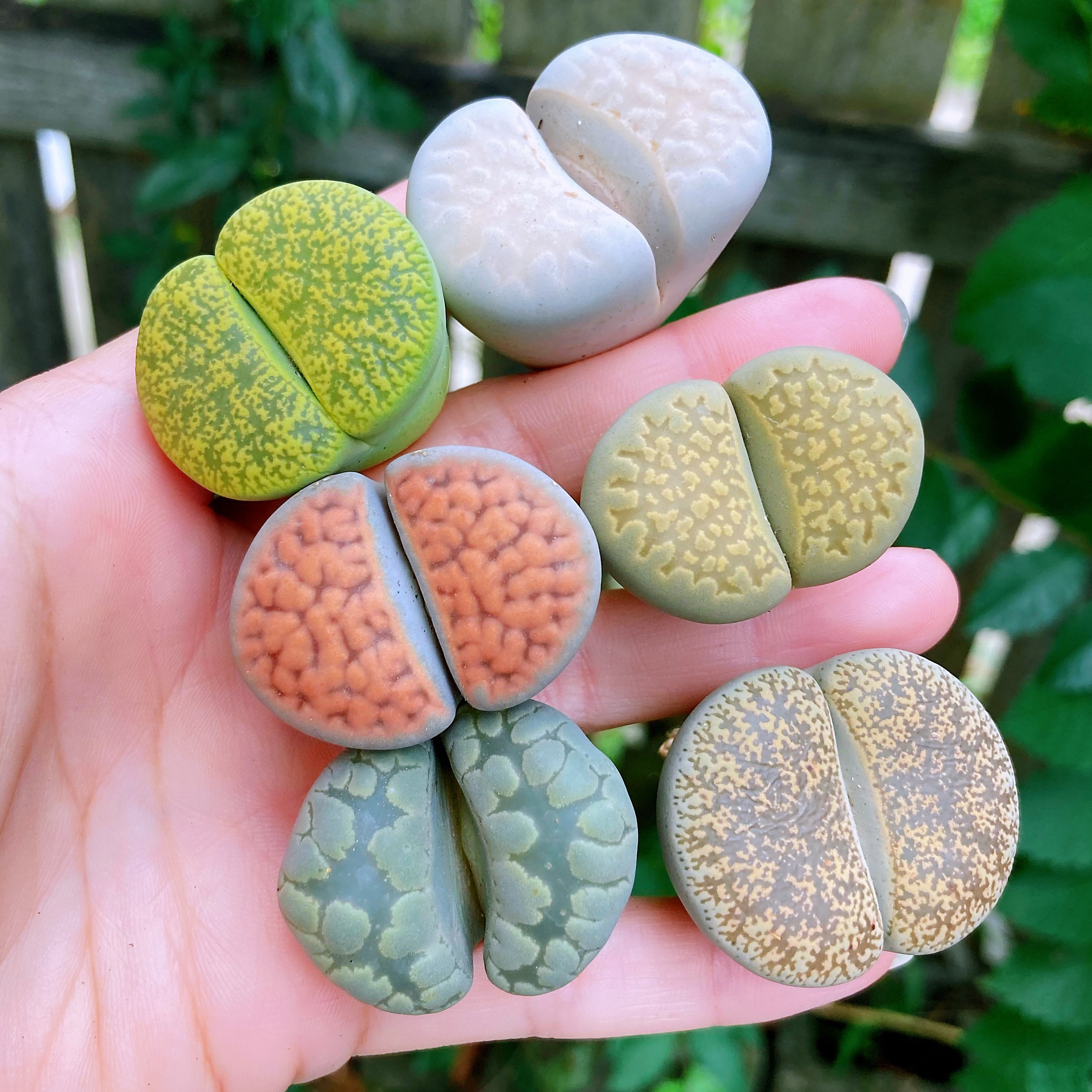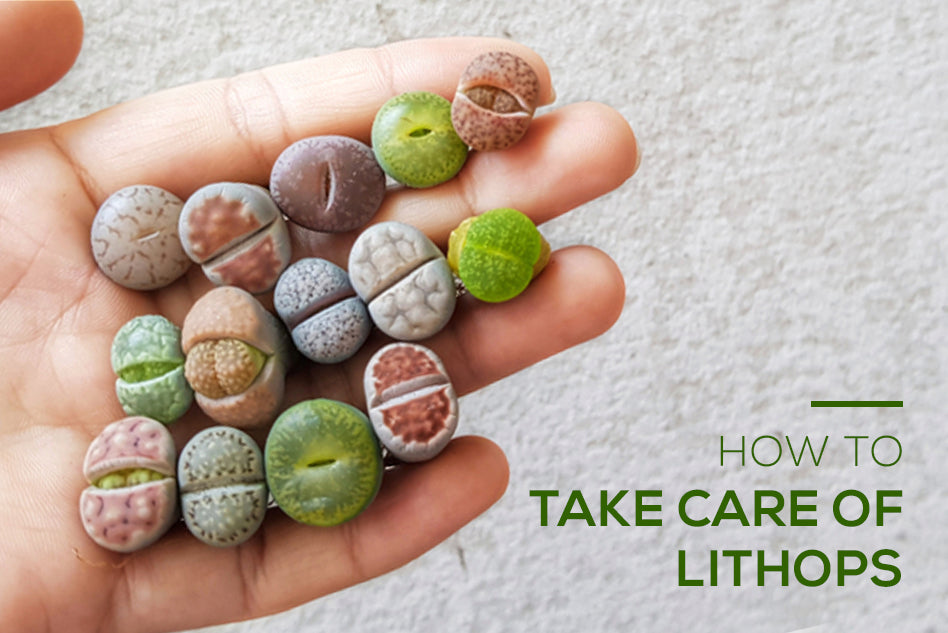These unique succulents are a favorite among collectors for their unusual shapes and hues. They are slow-growing plants that feature thick leaves and long roots that develop beneath the ground, and they must be watered carefully since they are very sensitive to excessive moisture.
Table of Contents
Care and Propagation Information
Lithops are an interesting choice for a rock garden or an indoor succulent garden, as their stem grows underneath the soil. The soil should be gritty and provide good drainage.
Lithops are not the easiest plants to grow for a beginner, as they are very dependent on their environment. Place them indoors in a spot that gets a lot of sunlight, such as a windowsill, and be patient with their growth. If you take care of them, you may be rewarded with yellow or white blooms in late Summer or early Autumn.
Watering
Lithops require a dramatically reduced amount of water compared to other succulents. During winter, when their leaves are splitting, it’s best to avoid watering at all. In Summer, when the leaves start to wrinkle, water sparingly. When watering again in Spring, wait until the old leaves have been shed and the new growth is visible.
It is advised to use the “soak and dry” technique for watering Lithops, which involves letting the soil become completely dry before watering it again. Overwatering can cause the plant’s leaves to explode.
Where to Plant
Lithops are not tolerant of cold temperatures, so if you live in an area where temperatures drop below freezing (30° F or -1.1° C), it is advisable to grow this succulent in a pot that can be brought indoors. This plant prefers full to partial sun.
If you’re growing indoors, make sure to locate the plants in a location that receives plenty of sunshine, such as close to a window facing south (if you live in the Northern Hemisphere).
How to Propagate Lithops
Although splitting Lithops plants is a viable method of propagation, the most successful way to increase the number of these plants is through their seeds. The seeds can be harvested from the plant’s flowers during the Summer or early Fall.
Additional information
Care and Propagation Information
General Care for Lithops
Lithops are an interesting choice for a rock garden or an indoor succulent garden, as their stem grows underneath the soil. The soil should be gritty and provide good drainage.
Lithops are not the easiest plants to grow for a beginner, as they are very dependent on their environment. Place them indoors in a spot that gets a lot of sunlight, such as a windowsill, and be patient with their growth. If you take care of them, you may be rewarded with yellow or white blooms in late Summer or early Autumn.
Watering
Lithops require a dramatically reduced amount of water compared to other succulents. During winter, when their leaves are splitting, it’s best to avoid watering at all. In Summer, when the leaves start to wrinkle, water sparingly. When watering again in Spring, wait until the old leaves have been shed and the new growth is visible.
It is advised to use the “soak and dry” technique for watering Lithops, which involves letting the soil become completely dry before watering it again. Overwatering can cause the plant’s leaves to explode.
Where to Plant
Lithops are not tolerant of cold temperatures, so if you live in an area where temperatures drop below freezing (30° F or -1.1° C), it is advisable to grow this succulent in a pot that can be brought indoors. This plant prefers full to partial sun.
If you’re growing indoors, make sure to locate the plants in a location that receives plenty of sunshine, such as close to a window facing south (if you live in the Northern Hemisphere).
How to Propagate Lithops
Although splitting Lithops plants is a viable method of propagation, the most successful way to increase the number of these plants is through their seeds. The seeds can be harvested from the plant’s flowers during the Summer or early Fall.
Additional information
Lithops are indigenous to Namibia and South Africa, where they are commonly referred to as “cattle hoof,” “sheep hoof” and “horse’s hoof.”
FAQ
How long does it take lithops to grow full size?
Planting the seeds in a sandy medium during the summer months and lightly watering them will enable them to develop rapidly and flower in 3 to 4 years if the ideal circumstances are present. Make sure the seeds are lightly covered with a thin layer of fine sand when done.
How big can lithops get?
Lithops are incredibly tiny plants; they have no stem and the majority of their body lies beneath the surface of the soil. The only visible part of the plant is the top, which can reach up to 0.5-1 inch in height.
How do you care for lithops indoors?
Lithops need plenty of bright light. To ensure they get the right amount, give them four to five hours of direct sunlight, followed by partial shade for the remainder of the day. A southern or eastern-facing window is an ideal spot for them to receive the correct amount of light. If you notice the leaves on your plant starting to lose their patterns and becoming longer in shape, it is likely a sign that they are not getting enough sunlight.
How often should you water lithops?
The frequency of watering depends on the rate at which the soil dries out. Generally, water thoroughly and let the soil dry completely before watering again, which should be around every 1-2 weeks. Allow a few days of drying in between each watering.
How do you take care of lithops?
Restate in other words: To rephrase the statement.



